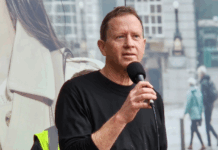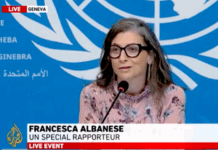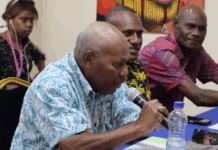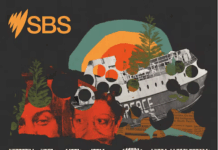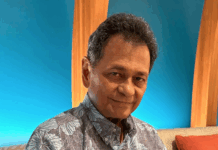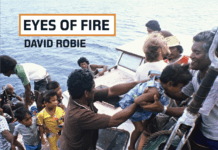
REVIEW: By Sri Krishnamurthi of Pacific Media Watch
When I first learned about the mythical place called Hawaiki. I understood it to be Cape Reinga at the tip of Aotearoa New Zealand’s North Island, where the two oceans meet – the Blue Pacific and the Tasman Sea.
As Māori told me, it was the place where their tupuna (ancestors) departed.
In this three-part series Origins (TVNZ), Scotty Morrison, a Te Reo expert and host of Te Karare, goes in search of his Hawaiki and much more beyond. It is a journey through the origins of time in search of where Māori came from.
It’s the universal question – who are we and how did we get here? Morrison travels “across the world and through time” to discover just that.
“When our ancestors were believed to be the last people on earth to inhabit these shores, I want to know who they were these people and how they got here,” he says.
He asks the question: “Were they great sailors or starving refugees?”
He goes back to his marae where the carvings depict his tupuna, including Tamate Kapua, captain of the first waka to bring his ancestors to these shores. However, the tales of legends is not enough to convince of roots.
Waka and names
The Ngati Whakaue man describes Hawaiki as the “Homeland” which is how the eldest of his three children is named.
As he explains, every iwi arrived on a different waka and his was no different, arriving as the Ngati Whakaue did on the waka of captain Tamate Kapua
After the tribulations, they finally arrived at Maketu where the Te Arawa iwi takes it name, settling in the Bay of Plenty. They believe the waka set of from a real place which he wants to visit.
In the first episode, he takes viewers of the documentary to the sacred archaeological site at Wairau Bar, or Te Pokohiwi, where some of the first people to arrive in Aotearoa, are buried.
“There is a whole lot of Hawaikis” says Sir Toby Curtis of Te Arawa. “The last Hawaiki is in the Pacific. The other Hawaikis are named in India and Africa before they moved to the Pacific.
“Wherever they stayed, that place was called Hawaiki.
“So, there are many places that are Hawaiki, but the Hawaikii we talk about is here is the Pacific,” the Te Arawa kaumatua says.
Keeps pointing to Rangitea
“The Hawaiki we talk about keeps on pointing back to Rangitea [in “French” Polynesia], and it is important because we want to know where we came from,” says Toby.
That is the quest that Morrison undertakes tracing the journey of the first people to arrive in New Zealand and also the history of the first people to walk the Earth which features him travelling from Polynesia to Asia to Africa.
As Morrison says, the story “starts here with us and the Māori story, but it turns into a story around human existence basically, and where we all seem to have originated from.”
The series was inspired by Meg Douglas of Scottie Productions who has worked on the project for nearly a decade and was motivated by the tales that her father narrated to her about his own epic journey to uncover and write about the origins of his own iwi.
And so, in 2018 Scottie Productions teamed up with Greenstone TV and TVNZ came on board to support the project.
Production started in early 2019. It was a massive task, with research being undertaken through immeasurable hours of sifting through papers, historical books, and talking to people all over New Zealand and the world.
The project began shooting in July 2019 and finished in January 2020 just before the covid-19 pandemic hit the world.
First tupuna to arrive
For Morrison, the next part of his journey was from the Wairau Bar, Te Pokohiwi, where some of the first tupuna to arrive are buried. After learning the secrets of history that the Bar had to offer him to give him a grounding it was time to move on.
Next, he goes to Tahiti, Eastern Polynesia where finds connections through language as he discovers that he can converse in te reo with a man speaking Tahitian Ma’ohi at the museum and similarities in language can only be described as remarkable.
The indigenous language is no longer commonplace but Ma’ohi is starting to enjoy a revival, as Morrison discovers.
He feels a connection to Tahiti even though the journey to Aotearoa is a 4000km and dangerous voyage.
As Jack Thatcher, a master builder from Aotearoa who prepares to sail his waka from Tahiti to New Zealand tells him: “Hawaiki is an ideal, it’s one of those places, it’s one of those places from whence we came and where we settled we had a Hawaiki back to Rarotonga, Tahitinui, Rangitea, so I think Hawaiki might just be moana,”
After travelling to Meheti’a, or Maketu, where voyagers made their final preparation, he then travels to Rangitea (or Rai’atea) to Taputapuatea, a Unesco World Heritage site on Rai’atea, which is said to be the launch place of Tamatekapua’s waka, Morrison’s Te Arawa ancestor.
“I feel as though I’m about to walk to into my tribe’s sacred places,” he says discovering that the Tainui, Te Arawa and Tokomaru waka left Rai’atea for Aotearoa.
Felt in the DNA
“This is a good point to start because when you come here we feel it in your DNA and genealogy as Maori and I think if you take the time to come here you’ll feel it to.”
The calm serenity on the beach where he sits on Rai’atea reveals that to be his personal Hawaiki.
Morrison learns how early Pākehā researchers got the origins of Māori so wrong. He is surprised to find that several traditional folktales in Samoa are replicated in Māori culture and he makes a shock personal discovery at an ancient Vanuatu urupa (burial place).
Much of Pakeha research is debunked by historian Dr Rawiri Taonui who says: “You really need to go in with your eyes and heart wide open because there is a lot of stuff in these books that are exciting and interesting but not true.”
Then in later episodes he explores links with Western Polynesia and goes to Western Samoa, Vanuatu and Taiwan, where Morrison says there are some linguistic similarities with te reo in an usurping discovery which tells the tale of his ancestors voyagers.
It surprises him that Māori may have travelled from Western Polynesia too and the discovery of Lapita pottery in Samoa then takes him to Vanuatu where it came from.
He is welcomed by a challenge by young warriors like a wero but it is the Lapita pots that gives a clue to the colonisation of Vanuatu where he similarities in the words found in common word.
Pots similar to Taiwan
But the Lapita pots are that similar to those found in Taiwan and in 2003 a major burial site or urupa (burial ground) was discovered.
In the final episode Morrison travels to Taiwan and Ethiopia to explore the place that is said to be the origin of us all, and he visits the Cook Islands – the stepping off point for waka heading to Aotearoa hundreds of years ago.
He travels to Eastern Taiwan which hasn’t been inhabited by the Han Chinese and ancient rituals still hold true.
Once again he finds similarities in the language when he ask an indigenous sailor to recite numbers to 10. And he travels inland to find a structure not to dissimilar to the Wharenui back home.
“It is extraordinary how similar this whare is to the whare back home,” Morrison says in astonishment.
However, his last stop 8000 km away in Addis Abba, Ethiopia, said to be “cradle of humanity” and one which Sir Toby Curtis spoke as a knowing elder of Te Arawa.
He discovers the bones of “Lucy” a 3.2 million-year-old woman whose relics can be found at the National Museum of Ethiopia.
Left in ‘search for food’
As it explained to him by the curator of the mueum, human beings left in “search of food”.
In Ethiopia, he visits the Omo Valley where the cradle of humanity is said to be and where the oldest, completely formed human skeleton was found.
The question of where we come from is “always going to be something that’s debated,” says Morrison, and there are many varying beliefs about how we came to be here.
While visiting with a traditional tribal group in the Omo River Valley, Morrison met a chief who took umbrage at the most popular theory of human evolution.
“I said through an interpreter, ‘Do you believe in the theory that eventually monkeys stood up and walked out of the bush and that was the evolution of human beings?’
“And the chief who I was talking to said to the interpreter, ‘Tell him if he says that to me again I’m going to take his head off’,” laughs Morrison
From visiting the Hamar people in Omo River Valley he then returns fron the 5000-year-old journey to the Cook Islands and to familiar surroundings to where three waka sailed – Te Arawa, Tainui and Takitimu.
The afterbirth is buried
As a master builder and carver from Rarotonga Mike Tavaoni says: Avaiki (Hawaiki) is where you are born, where afterbirth is buried. It is simply where you originated,” that is what it means to the Cook Island Māori.
“Ultimately (the journey) has strengthened my commitment to my own Maori culture and I finish in the firm belief that I visited my Hawaikii in Ra’aitea,” says Morrison.
The documentary is a mammoth feat of research and travel and does much to tell where Māori originated from.
- Origins: In search of the mythical Hawaiki and beyond (TVNZ), a three-part documentary series.
Director: Dan Salmon - Camera-man: Jack Bryant
TVNZ On Demand


